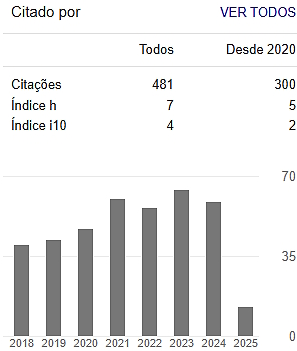CLASSIFICAÇÃO DE SUPERFÍCIES IMPERMEÁVEIS EM IMAGEM MULTIESPECTRAL COM ALGORITMO DE MACHINE LEARNING
Palavras-chave:
classificação, inteligência artificial, superfícies impermeáveisResumo
O processo de urbanização expõe a paisagem urbana a rápidas e constantes transformações. A mudança nos padrões de uso e cobertura do solo impacta diretamente na qualidade de vida das cidades. Por isso o monitoramento da composição territorial urbana se torna fundamental para a gestão urbana. Para obter acesso a esses dados, estudos vem aplicando técnicas de sensoriamento remoto aliada à aprendizagem de máquina (machine learning). As imagens de satélites oferecem dados em larga escala e com alta resolução temporal, facilitando a detecção de mudanças na paisagem. Já os algoritmos de machine learning proporcionam classificações com maior acurácia em relação aos métodos tradicionais. A partir desse contexto e das técnicas disponíveis, o estudo tem como objetivo avaliar o desempenho do algoritmo Support Vector Machine (SVM) em quantificar áreas impermeáveis no perímetro urbano de Presidente Prudente a partir de uma imagem Planet. O processo de classificação foi feito por meio do software ArcGIS Pro. Os resultados demonstram alto desempenho para o SVM quando aplicado em classificação de áreas impermeáveis em território urbano. A acurácia de 94% evidencia que o método proposto no trabalho é útil como ferramenta para o planejamento urbano.
Downloads
Referências
AGUILAR, R.; KUFFER, M. (2020). Cloud computation using high-resolution images for improving the SDG indicator on open spaces. Remote Sens., 12, 1144. https://doi.org/10.3390/rs12071144
AVUDAIAMMAL, R.; ELAVENI, P.; SELVAN, S.; RAJANGAM, V (2020). Extraction of Buildings in Urban Area for Surface Area Assessment from Satellite Imagery based on Morphological Building Index using SVM Classifier. J. Indian Soc. Remote. Sens., 48, 1325–1344. https://doi.org/10.1007/s12524-020-01161-0
DENG, X., LIU, Q., DENG, Y., & MAHADEVAN, S. (2016). An improved method to construct basic probability assignment based on the confusion matrix for classification problem. Information Sciences, 340-341, 250–261. https://doi.org/10.1016/j.ins.2016.01.033
DOU, Y.; KUANG, W. (2020). A comparative analysis of urban impervious surface and green space and their dynamics among 318 different size cities in China in the past 25 years. Sci. Total Environ., 706, 135828. https://doi.org/10.1016/j.scitotenv.2019.135828
ESRI - ARCGIS PRO (2021a). The Image Classification Wizard. Disponível em: < https://pro.arcgis.com/en/pro-app/latest/help/analysis/image-analyst/the-image-classification-wizard.htm>. Acesso em: 29 maio 2021.
ESRI - ARCGIS PRO (2021b). Accuracy Assessment. Disponível em: < https://pro.arcgis.com/en/pro-app/latest/help/analysis/image-analyst/accuracy-assessment.htm>. Acesso em: 08 junho 2021.
IBGE – INSTITUTO BRASILEIRO DE GEOGRAFIA E ESTATÍSTICA (2021). Cidades e Estados – Presidente Prudente. Disponível em: < https://www.ibge.gov.br/cidades-e-estados/sp/presidente-prudente.html>. Acesso em: 03 agosto 2021.
KESIKOGLU, M.H., OZKAN, C. & KAYNAK, T. (2021). The impact of impervious surface, vegetation, and soil areas on land surface temperatures in a semi-arid region using Landsat satellite images enriched with Ndaisi method data. Environ Monit Assess 193, 143. https://doi.org/10.1007/s10661-021-08916-3
LIN, Y.; ZHANG, H.; LIN, H.; GAMBA, P.; LIU, X. (2020). Incorporating synthetic aperture radar and optical images to investigate the annual dynamics of anthropogenic impervious surface at large scale. Remote Sens. Environ., 242, 111757. https://doi.org/10.1016/j.rse.2020.111757
MCLAUGHLIN, C; HUTSON, H; DE VINE, L; WOODLEY, A; GEVA, S; CHAPPELL T. (2019). Change detection over the state of Queensland using high resolution Planet satellite mosaics, Digital Image Computing: Techniques and Applications (DICTA), pp. 1-8. https://doi.org/10.1109/DICTA47822.2019.8945942
MICHAEL, Y.; LENSKY, I.M.; BRENNER, S.; TCHETCHIK, A.; TESSLER, N.; HELMAN, D. (2018). Economic Assessment of Fire Damage to Urban Forest in the Wildland-Urban Interface Using Planet Satellites Constellation Images. Remote Sens., 10, 1479. https://doi.org/10.3390/rs10091479
MISRA, M., D. KUMAR, AND S. SHEKHAR. (2020). Assessing Machine Learning Based Supervised Classifiers for Built-Up Impervious Surface Area Extraction from Sentinel-2 Images. Urban Forestry & Urban Greening. 53: 126714. https://doi.org/10.1016/j.ufug.2020.126714
MORABITO, M.; CRISCI, A.; GUERRI, G.; MESSERI, A.; CONGEDO, L.; MUNAFÒ, M. (2021). Surface urban heat islands in Italian metropolitan cities: Tree cover and impervious surface influences. Sci. Total Environ., 751, 142334. https://doi.org/10.1016/j.scitotenv.2020.142334
RAHMAN, A; ABDULLAH, H.M; TANZIR, M.T; HOSSAIN, M.J; KHAN, B.M; MIAH, M.G; ISLAM, I. (2020). Performance of different machine learning algorithms on satellite image classification in rural and urban setup. Rem. Sens. Appl. Soc. Environ., 20, p. 10041. https://doi.org/10.1016/j.rsase.2020.100410
RUUSKA, S., HÄMÄLÄINEN, W., KAJAVA, S., MUGHAL, M., MATILAINEN, P., & MONONEN, J. (2018). Evaluation of the confusion matrix method in the validation of an automated system for measuring feeding behaviour of cattle. Behavioural Processes, 148, 56–62. https://doi.org/10.1016/j.beproc.2018.01.004
TANG, P; DU, P; LIN, C; GUO, S; QIE. L. (2020). A novel sample selection method for impervious surface area mapping using JL1-3B nighttime light and Sentinel-2 imagery. IEEE J. Sel. Top. Appl. Earth Obs. Remote Sens. p. 1. https://doi.org/10.1109/JSTARS.2020.3004654
WELLMANN, T.; LAUSCH, A.; ANDERSSON, E.; KNAPP, S.; CORTINOVIS, C.; JACHE, J.; SCHEUER, S.; KREMER, P.; MASCARENHAS, A.; KRAEMER, R.; ET AL. (2020). Remote sensing in urban planning: Contributions towards ecologically sound policies? Landsc. Urban Plan. 204, 103921. https://doi.org/10.1016/j.landurbplan.2020.103921
XU, S.; QING, L.; HAN, L.; LIU, M.; PENG, Y.; SHEN, L. (2020). A New Remote Sensing Images and Point-of-Interest Fused (RPF) Model for Sensing Urban Functional Regions. Remote Sens. 12, 1032. https://doi.org/10.3390/rs12061032
ZENG, Q., XIE, Y., & LIU, K. (2019). Assessment of the patterns of urban land covers and impervious surface areas: A case study of Shenzhen, China. Physics and Chemistry of the Earth 110, 1-7. https://doi.org/10.1016/j.pce.2019.04.002
ZHANG, L., ZHANG, M., & YAO, Y. (2018). Mapping seasonal impervious surface dynamics in Wuhan urban agglomeration, China from 2000 to 2016. International Journal of Applied Earth Observation and Geoinformation, 70, 51–61. https://doi.org/10.1016/j.jag.2018.04.005

